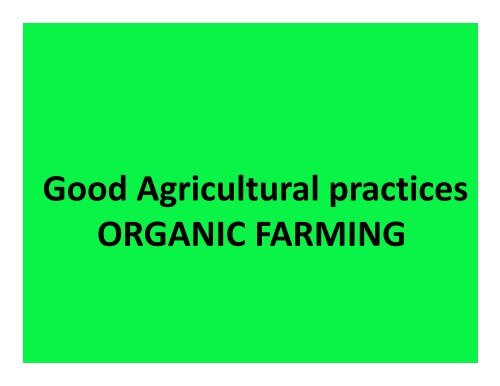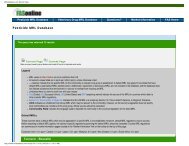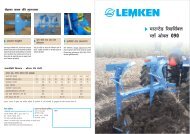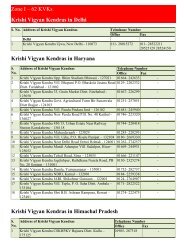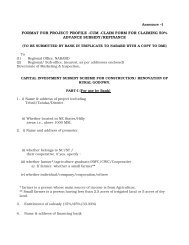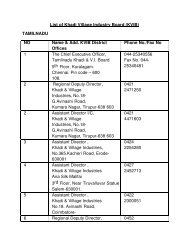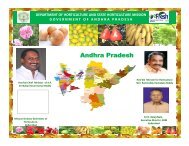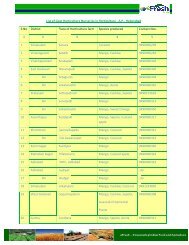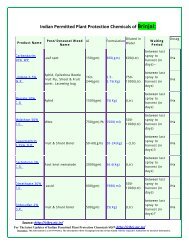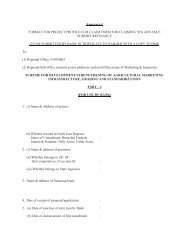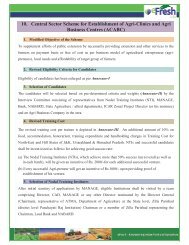Good Agricultural practices ORGANIC FARMING - Efresh India
Good Agricultural practices ORGANIC FARMING - Efresh India
Good Agricultural practices ORGANIC FARMING - Efresh India
Create successful ePaper yourself
Turn your PDF publications into a flip-book with our unique Google optimized e-Paper software.
<strong>Good</strong> <strong>Agricultural</strong> <strong>practices</strong><br />
<strong>ORGANIC</strong> <strong>FARMING</strong>
<strong>ORGANIC</strong> <strong>FARMING</strong><br />
ORIGIN<br />
• JI J.I. Rodale coined the word “organic”<br />
(1940’s)principal figure in U.S. organic<br />
agriculture.<br />
• Rodale’s concepts drawn primarily from<br />
British agronomists Sir Albert Howard<br />
‐“An <strong>Agricultural</strong> Testament” (1943)<br />
‐ “The Soil and Health” (1947)<br />
‐Natural approach to building soil<br />
‐fertility, return wastes to the soil<br />
J.I. Rodale<br />
The Pioneers<br />
Sir Albert Howard
<strong>ORGANIC</strong> <strong>FARMING</strong><br />
• What is organic farming?<br />
• Organic farming works in harmony with nature<br />
rather than against it. This involves<br />
• using techniques to achieve good crop yields<br />
without harming the natural<br />
• environment or the people who live and work in<br />
it.<br />
• The methods and materials that organic farmers<br />
use are summarised as follows:
<strong>ORGANIC</strong> <strong>FARMING</strong><br />
• To keep and build good soil structure and<br />
fertility:<br />
• recycled and composted crop wastes and<br />
animal manures<br />
• the right soil cultivation at the right time<br />
• crop rotation<br />
• green manures and legumes<br />
• mulching lh on the soil surface
<strong>ORGANIC</strong> <strong>FARMING</strong><br />
To control pests, diseases and weeds:<br />
• careful planning and crop choice<br />
• the use of resistant crops<br />
• good cultivation practice<br />
• crop rotation<br />
• encouraging useful predators dt that t eat pests<br />
• increasing genetic diversity<br />
• using natural pesticides<br />
Organic farming also involves:<br />
• careful use of water resources<br />
• good animal husbandry
• Definitions:<br />
<strong>ORGANIC</strong> <strong>FARMING</strong><br />
• As per National Organic Standards Board :<br />
“an ecological production management system that<br />
promotes and enhances biodiversity, biological cycles<br />
and soil biological activity. It is based on minimal use of<br />
off‐farm farm inputs and on management <strong>practices</strong> that<br />
restore, maintain and enhance ecological harmony.”<br />
• According to the definition of the Codex Alimentarius:<br />
“Organic agriculture is a holistic production management<br />
system which promotes and enhances agro‐ecosystem<br />
health , including biodiversity ,biological cycles and soil<br />
biological activity”.
<strong>ORGANIC</strong> <strong>FARMING</strong><br />
• Products labeled as “Organic” are those certified as<br />
having been produced through clearly defined organic<br />
production methods.<br />
• In other words “Organic” is a claim li on the<br />
production process rather than a claim on the product<br />
itself.
<strong>ORGANIC</strong> <strong>FARMING</strong><br />
Foundational Principles & Practices of organic Crop Production
<strong>ORGANIC</strong> <strong>FARMING</strong><br />
PRACTICES &TOOLS FOR <strong>ORGANIC</strong> CROP PRODUCTION<br />
• Crop Rotation<br />
• Green manures & cover crops<br />
• Manures & compost<br />
• Intercropping & companion planting<br />
• Biological pest control<br />
• Mulching lhi<br />
• Biorational pesticides<br />
• Buffers & barriers<br />
CONSTRAINTS AND CHALLENGES OF <strong>ORGANIC</strong> <strong>FARMING</strong> IN<br />
INDIA<br />
• Organic agriculture in <strong>India</strong> is not keeping in tune with the rising demand<br />
for organic products<br />
• Flow chart below illustrate key factors limiting organic agriculture in<br />
<strong>India</strong> .
<strong>ORGANIC</strong> <strong>FARMING</strong>
<strong>ORGANIC</strong> <strong>FARMING</strong><br />
STATUS OF <strong>ORGANIC</strong> <strong>FARMING</strong><br />
INDIAN SCENARIO:<br />
•It is estimated that 65%of the countries cropped area is organic by<br />
default in view of fragmented land holdings and limited financial<br />
capacity to use chemical fertilizers and pesticides<br />
•<strong>India</strong>’s inherent advantages viz. Varied agro climatic regions, Local<br />
self sustaining agri systems ,sizable no. of progressive farmers and<br />
readily available inexpensive manpower favours cultivation of vast<br />
baskets of organic products.<br />
•Area under certified organic farming in <strong>India</strong> is estimated at 2.5<br />
million hectors ,inclusive of 2.4 24million hectors of wild herbs in the<br />
forest areas of M.P.& U.P.
<strong>ORGANIC</strong> <strong>FARMING</strong><br />
MAJOR CROP PRODUCTS PRODUCED IN INDIA UNDER <strong>ORGANIC</strong> <strong>FARMING</strong>
<strong>ORGANIC</strong> <strong>FARMING</strong><br />
Percentage share of organic products in <strong>India</strong>
<strong>ORGANIC</strong> <strong>FARMING</strong><br />
Geographical spread of organic cropped area in <strong>India</strong>
<strong>ORGANIC</strong> <strong>FARMING</strong><br />
Domestic Demand<br />
• Although the domestic market is nascent, there is huge growth<br />
potential<br />
• Presently the market ktis confined mostly to Mt Metros & tier 1 cities<br />
• Lack of assured supplies is hampering the demand satisfaction<br />
Export Market:<br />
•<strong>India</strong> exports over 31 organic products .Organic agriculture export<br />
marketis one of the major drivers of organic agriculture in <strong>India</strong>.<br />
•<strong>India</strong> is best known as the biggest exporter of Organic tea.other<br />
organic products with a niche markets are Spices and Fruits.<br />
•Among the fruit crops, Bananas ,Mangoes & Oranges are the most<br />
preferred organic products.<br />
Key organic items of export importance are fruits and vegetables,<br />
sesame, basmati rice , fruit pulp, fruit juices, spices, cashew, tea,<br />
coffee, cotton and wheat. <strong>India</strong> has production advantages in most<br />
of these products
<strong>ORGANIC</strong> <strong>FARMING</strong><br />
STATUS OF <strong>ORGANIC</strong> <strong>FARMING</strong><br />
WORLD SCENARIO:<br />
‣35 million hectares of agricultural land are managed organically<br />
‣In addition to the certified organic agricultural land (including<br />
‣ in‐conversion areas) there are:<br />
• 0.4 million hectares of organic aquaculture areas<br />
• 31.1 million hectares of organic wild collection and bee keeping<br />
areas<br />
• 0.3 million hectares of further non‐agricultural land<br />
‣More than one third of the world‘s organic agricultural land is in<br />
Oceania (35%) , followed by Europe and Latin America (both<br />
23%).<br />
‣Eight countries have more than 1 million hectares of organic<br />
agricultural land.<br />
‣ Six countries/areas have more than 10 percent organic land.<br />
‣ 1.4 million organic producers were reported.
<strong>ORGANIC</strong> <strong>FARMING</strong><br />
Geographical Spread of Organic <strong>Agricultural</strong> land Across The World ‐ 2008
<strong>ORGANIC</strong> <strong>FARMING</strong><br />
Top 10 Countries Engaged In Organic Farming ‐ 2008
<strong>ORGANIC</strong> <strong>FARMING</strong><br />
Development of organic agricultural land and other organic areas 1999 to 2008
<strong>ORGANIC</strong> <strong>FARMING</strong><br />
Top 10 Countries With The Largest Numbers Of Organic Producers 2008
<strong>ORGANIC</strong> <strong>FARMING</strong><br />
Global organic market: The ten countries with the largest markets for organic<br />
g g g<br />
food 2008
<strong>ORGANIC</strong> <strong>FARMING</strong><br />
OUTLOOK<br />
According to a report on organic agriculture prepared by<br />
UNEPUNCTAD , the global market for certified organic<br />
products is forecast to increase to 52 billion Euros by<br />
2012. Markets in developed countries are evolving to<br />
increase their demand for highly processed organic<br />
products as well as raw commodities.<br />
Besides fresh fruits and vegetables, potential sectors for<br />
growth include organic dairy, organic meat and<br />
aquaculture.
<strong>ORGANIC</strong> <strong>FARMING</strong><br />
<strong>ORGANIC</strong> CERTIFICATION PROCESS
<strong>ORGANIC</strong> <strong>FARMING</strong><br />
WHAT CAN BE CERTIFIED ?<br />
Crop production<br />
Animal husbandry
Food processing<br />
<strong>ORGANIC</strong> <strong>FARMING</strong><br />
WHAT CAN BE CERTIFIED ?<br />
Handling
<strong>ORGANIC</strong> <strong>FARMING</strong><br />
Operations that can be certified<br />
• Individual Farms<br />
• Groups (small holder organisation,contract)<br />
• Processors<br />
• Packers<br />
• Retailers<br />
• Traders/exporters<br />
• Importers<br />
The entire supply chain must undergo certification
<strong>ORGANIC</strong> <strong>FARMING</strong>
<strong>ORGANIC</strong> <strong>FARMING</strong>
<strong>ORGANIC</strong> <strong>FARMING</strong>
<strong>ORGANIC</strong> <strong>FARMING</strong><br />
Steps towards certification<br />
Choice of certifier<br />
• market requirements → certification standard(s)<br />
• must have the required accreditations for<br />
these standards<br />
• ISO 65 and /or IFOAM approval or accreditation &<br />
APEDA<br />
• competent, good service<br />
• good reputation, well accepted by buyers<br />
• price comparison
<strong>ORGANIC</strong> <strong>FARMING</strong><br />
Operational Structure of National program for Organic<br />
Production(NPOP) – <strong>India</strong>n Standard<br />
Government Of <strong>India</strong><br />
Steering Committee for<br />
NPOP(members appointed by MoC)<br />
Accreditation Body (APEDA)<br />
Inspection Certification<br />
i<br />
Agency<br />
Farmers<br />
Traders<br />
Processors
<strong>ORGANIC</strong> <strong>FARMING</strong><br />
WHAT ARE GROWER GROUPS?<br />
Group of small holding farmers<br />
Establish a legal entity for themselves-<br />
(cooperative,society,federation,etc)<br />
Contract t production, small scale processing units may also be<br />
certified<br />
Exporters,processors can be a part of the group.
<strong>ORGANIC</strong> <strong>FARMING</strong><br />
REQUIREMENTS FOR GROWER GROUP<br />
CERTIFICATION UNDER CROP PRODUCTION<br />
<br />
At least half of the total land holding in the group should belong to farmers<br />
having less than 4 Ha. No limit to the total area.<br />
A minimum of 25 farmers should go into a grower group. Maximum 500<br />
farmers in a group.<br />
<br />
<br />
<br />
<br />
<br />
The farms have to be in geographical proximity.<br />
Similar cropping system must be adopted.<br />
Internal quality system should be maintained through ICS (Internal control<br />
system)<br />
Common certificate given to the entire group.<br />
Common marketing of the entire produce from the group.
<strong>ORGANIC</strong> <strong>FARMING</strong>
<strong>ORGANIC</strong> <strong>FARMING</strong>
<strong>ORGANIC</strong> <strong>FARMING</strong>
<strong>ORGANIC</strong> <strong>FARMING</strong>
<strong>ORGANIC</strong> <strong>FARMING</strong>
<strong>ORGANIC</strong> <strong>FARMING</strong>
<strong>ORGANIC</strong> <strong>FARMING</strong>
<strong>ORGANIC</strong> <strong>FARMING</strong>
<strong>ORGANIC</strong> <strong>FARMING</strong>
<strong>ORGANIC</strong> <strong>FARMING</strong>
<strong>ORGANIC</strong> <strong>FARMING</strong>
<strong>ORGANIC</strong> <strong>FARMING</strong>
<strong>ORGANIC</strong> <strong>FARMING</strong>
<strong>ORGANIC</strong> <strong>FARMING</strong>
<strong>ORGANIC</strong> <strong>FARMING</strong>
<strong>ORGANIC</strong> <strong>FARMING</strong>
<strong>ORGANIC</strong> <strong>FARMING</strong>
<strong>ORGANIC</strong> <strong>FARMING</strong>
<strong>ORGANIC</strong> <strong>FARMING</strong>
<strong>ORGANIC</strong> <strong>FARMING</strong><br />
Organic certification Standards- NPOP<br />
• National Standards for<br />
production, processing,<br />
labeling, storage and<br />
transport of organic products<br />
• Accreditation Criteria for<br />
Certification and Inspection<br />
Agencies Ministry of<br />
Commerce and Industry, New<br />
Delhi
<strong>ORGANIC</strong> <strong>FARMING</strong><br />
Contents of Organic Standards<br />
3.2Crop<br />
Production<br />
3.1General<br />
3.3 Animal<br />
Husbandry<br />
Organic<br />
Standards<br />
3.6 Storage<br />
&<br />
Transport<br />
3.4 Food<br />
Processing<br />
/Handling<br />
35L 3.5 Labelling
<strong>ORGANIC</strong> <strong>FARMING</strong><br />
General Structure of each chapter / sub chapter<br />
•General<br />
Principle<br />
•Recomm<br />
endations<br />
•Standards<br />
of organic standard consists of
<strong>ORGANIC</strong> <strong>FARMING</strong><br />
Subsections of the standards 3.1 and 3.2<br />
3.1General<br />
3.2Crop<br />
Production<br />
Conversion<br />
Period<br />
Conversion Requirements<br />
Landscape<br />
Crop Diversity<br />
Fertilization Policy<br />
Pest, disease and weed<br />
management<br />
Contamination<br />
Planting<br />
Material<br />
Soil il& Water Wt<br />
Conservation
<strong>ORGANIC</strong> <strong>FARMING</strong><br />
Conversion Requirements<br />
• Starts from the date of<br />
Application to CB<br />
• Organic and conventional<br />
parts (Part farm conversion)<br />
• must be separate and<br />
inspectable<br />
• Simultaneous production of<br />
conventional, in conversion<br />
and or organic crops which<br />
cannot be clearly distinguished<br />
from each other is not allowed
<strong>ORGANIC</strong> <strong>FARMING</strong><br />
Parallel Production not allowed<br />
Organic pineapplepp<br />
Conventional pineapple
<strong>ORGANIC</strong> <strong>FARMING</strong><br />
Planting material<br />
• When organic planting materials are<br />
available they shall be used<br />
• When certified organic planting materials<br />
are not available, chemically untreated<br />
conventional materials shall be used<br />
• The use of genetically engineered seeds,<br />
pollen,transgene plants or planting<br />
material is not allowed
<strong>ORGANIC</strong> <strong>FARMING</strong><br />
Conversion Period<br />
• Annuals-when the national<br />
standard requirements have been<br />
met for a minimum of 24 months<br />
before the start of production<br />
cycle<br />
• Perennials-when the national<br />
standard requirements have been<br />
met for a minimum of 36 months<br />
before harvest<br />
• The conversion period can be<br />
extended by the certification<br />
programme depending on past<br />
use of land and environmental<br />
conditions.It can also be reduced<br />
,minimum period 12 months
<strong>ORGANIC</strong> <strong>FARMING</strong><br />
Fertilization Policy<br />
• Biodegradable material of microbial,<br />
plant or animal origin forms the basis<br />
• The total amount of microbial, plant<br />
or animal origin shall be limited by<br />
certification programme<br />
• Mineral fertilizers to be applied in their<br />
natural composition and not to be<br />
rendered soluble by chemical<br />
treatment. Exceptions as permitted by<br />
certification agency<br />
• Chilean nitrate & all synthetic<br />
nitrogenous fertilizers including urea<br />
are prohibited<br />
• Please refer to NPOP Appendix 1 for a<br />
detailed list of allowed inputs
<strong>ORGANIC</strong> <strong>FARMING</strong><br />
Pest, Disease and Weed management<br />
• Plant, animal & microbial<br />
products locally produced at<br />
the farm are allowed<br />
• The use of synthetic herbicides,<br />
fungicides, insecticides and<br />
other pesticides is prohibited<br />
• Farm equipments from<br />
conventional farming systems<br />
shall be free from residues &<br />
clean
<strong>ORGANIC</strong> <strong>FARMING</strong><br />
Pest, Disease and Weed management……..<br />
• Thermic sterilisation of soils in<br />
places where a proper rotation or<br />
renewal of soil cannot take place<br />
as permitted by certification<br />
agency<br />
• Use of synthetic growth regulators<br />
& synthetic dyes prohibited<br />
• Use of genetically engineered<br />
organisms or products are<br />
prohibited
<strong>ORGANIC</strong> <strong>FARMING</strong><br />
Soil and Water conservation<br />
• Clearing of land by burning organic matter<br />
shall be restricted to the minimum<br />
• Clearing of primary forest is prohibited<br />
• Relevant measures shall be taken to prevent<br />
erosion.<br />
• Excessive exploitation and depletion of<br />
water resources shall not be allowed.<br />
• Relevant measures shall be taken to prevent<br />
salination of soil and water
<strong>ORGANIC</strong> <strong>FARMING</strong><br />
33A 3.3 Animal lHusbandry 1. AH Management<br />
2. AH Conversion Period<br />
3. Brought in animals<br />
4. Breeds and Breeding<br />
5. Mutilations<br />
6. Animal Nutrition<br />
7. Veterinary Medicine<br />
8. Transport and Slaughter<br />
9. Bee keeping
<strong>ORGANIC</strong> <strong>FARMING</strong><br />
3.3.1 Animal Husbandry Management<br />
•Should provide for free movement,<br />
fresh air ,natural daylight, in tune<br />
with behavioral needs<br />
•Access to fresh water, feeding, resting<br />
and bedding facilities according to<br />
the needs of animals<br />
•Access to open air & grazing to be<br />
ensured<br />
•Poultry & rabbits shall not be kept<br />
in cages<br />
•Landless Animal Husbandry systems<br />
not allowed<br />
•Artificial lighting standards laid by<br />
the certification agency<br />
•Herd animals not to be kept individually<br />
except in allowed cases
<strong>ORGANIC</strong> <strong>FARMING</strong><br />
3.3.2. AH conversion period<br />
• Animal products to be sold as<br />
organic only after the farm or<br />
relevant part of it has been<br />
under conversion for at least<br />
12 months<br />
• For dairy and egg production<br />
the animal production standard<br />
should have been met for not<br />
less than 30 days<br />
• Organic meat may be sold when<br />
the organic standards for<br />
the animals onthe farm have<br />
been met for 12 months
<strong>ORGANIC</strong> <strong>FARMING</strong><br />
3.3.3. Brought – in Animals<br />
Non-availability of organic livestock to be substituted by brought in<br />
animals as per given age limits:<br />
• 2 day old chickens for meat production<br />
• 18 weeks old hens for egg production<br />
• 2 weeks old for any other poultry<br />
• Piglets-6 weeks and after weaning<br />
• Calves upto 4 weeks which have received colustrum<br />
• Breeding Stock brought in from conventional farms with a yearly<br />
y<br />
maximum of 10%of adult animals of the same species on the farm
<strong>ORGANIC</strong> <strong>FARMING</strong><br />
334 3.3.4. Breeds and Breeding<br />
• Breeding System should ensure<br />
natural breeding<br />
• Artificial insemination is allowed<br />
• Embryo Transfer not allowed<br />
• Hormonal heat treatment and<br />
induced birth not allowed<br />
unless for medical reasons<br />
• Genetically Engineered<br />
species or breeds<br />
not allowed
335 3.3.5. Mutilations<br />
Mutilations are<br />
not allowed but<br />
castration ,tail<br />
docking,<br />
dehorning<br />
ringing are<br />
exceptions<br />
Sufferings shall be<br />
minimized and<br />
anesthetics used<br />
where<br />
appropriate<br />
<strong>ORGANIC</strong> <strong>FARMING</strong>
<strong>ORGANIC</strong> <strong>FARMING</strong><br />
3.3.6. Animal Nutrition<br />
•Certification programme shall<br />
draw up standards for feed<br />
and feed ingredients<br />
•At least 50% of the feed shall<br />
come from the farm itself or<br />
produced in co-operation with<br />
other farms in the region<br />
•Feed produced on the farm<br />
unit during first year of organic<br />
management may be classed<br />
as Organic<br />
•Synthetic chemicals, farm<br />
animal by-products, all types of<br />
excreta, pure amino acids,<br />
GMO not to be used in<br />
conventional and organic<br />
feeds
3.3.7. Veterinary Medicine<br />
•Use of conventional medicines<br />
when no other alternative is<br />
available.<br />
•Use of synthetic growth promoters,<br />
suppressors not to be used<br />
& Hormones for heat induction<br />
synchronization for reproductive<br />
disorders justified by veterinary<br />
indications<br />
•Vaccinations only when diseases<br />
are a problem in the region and<br />
cannot be controlled by other means<br />
as defined by certification agency<br />
•Legally required vaccines are<br />
allowed<br />
•Genetically engineered vaccines<br />
prohibited
3.3.8. Transport and Slaughter<br />
•Throughout the process a<br />
person shall be responsible for<br />
the well being of the animal<br />
•Handling during transport and<br />
slaughter shall be calm and<br />
gentle<br />
•The use of electric sticks and<br />
such instruments are prohibited<br />
•Chemically synthesised<br />
tranquilisers or stimulants shall not<br />
be given prior to or during<br />
transport<br />
•The journey time to the<br />
slaughter house by road shall not<br />
exceed 8 hours
<strong>ORGANIC</strong> <strong>FARMING</strong><br />
3.3.9. Bee keeping.<br />
•Hives shall be situated in organically<br />
managed field and/ or wild natural areas<br />
and not to be close to conventional fields<br />
with exceptions made by certification<br />
bodies<br />
•Feeding only after last harvest before the<br />
monsoon when foraging feed is<br />
unavailable<br />
•Hives primarily made of natural materials<br />
•Wing clipping not allowed<br />
•Veterinary medicines not allowed<br />
•For pest & disease control disinfection<br />
formic, lactic, oxalic & acetic acids,<br />
sulphur, etheric oil & bacillus thuringiensis<br />
used<br />
•Persistent materials not to be used where<br />
there is possibility ii of permeation of honey &<br />
where residues are distributed in the area<br />
through dead bees
<strong>ORGANIC</strong> <strong>FARMING</strong><br />
Food and Food Processing<br />
1. General<br />
2. Pest and Disease Control<br />
3. Ingredients, Additives etc<br />
4. Processing Methods<br />
5. Packaging
341 3.4.1. General<br />
<strong>ORGANIC</strong> <strong>FARMING</strong><br />
•Co-mingling of organic and inorganic<br />
products not allowed<br />
•Certification prgramme shall set standards<br />
to prevent and control pollutants and<br />
contaminants<br />
•Organic and non-organic organic products shall<br />
not be stored and transported together<br />
except when labelled or separated together<br />
•The means and measures for<br />
decontamination ,cleaning or disinfection of<br />
all facilities where organic products are kept,<br />
handled, processed or stored shall be<br />
regulated by the certification programme<br />
•Storage at ambient temperature,<br />
controlled atmosphere cooling, freezing<br />
drying ,humidity regulation are the methods<br />
permitted for storage<br />
•Ethylene gas is permitted for ripening
<strong>ORGANIC</strong> <strong>FARMING</strong><br />
342 3.4.2. Pest and Disease control<br />
•Disruption ,elimination of habitat, access to<br />
facilities, mechanical biological and<br />
physical methods to control the pest in the<br />
order of priority<br />
•Irradiation is prohibited<br />
•There shall be no direct or indirect contact<br />
t<br />
between organic products and prohibited<br />
substances ( e.g. pesticides)<br />
•Persistent or carcinogenic pesticides and<br />
disinfectants are<br />
not allowed
<strong>ORGANIC</strong> <strong>FARMING</strong><br />
3.4.3. Ingredients, Additives and Processing aids<br />
•Non organic ingredients only as<br />
authorised by certification agency<br />
•One ingredient not to be both organic<br />
and non organic in origin<br />
•Water &salt may be used<br />
•Minerals, vitamins& isolated ingredients<br />
not to be used<br />
•Microbial &enzymatic preparations<br />
except GMO & their products can be<br />
used<br />
•Use of additives & processing aids to be<br />
restricted
<strong>ORGANIC</strong> <strong>FARMING</strong><br />
3.4.4 Processing Methods<br />
•Mechanical, physical, biological,<br />
smoking, extraction, precipitation,<br />
p<br />
filtration methods are allowed<br />
•Extraction with food grade quality<br />
water, ethanol, plant&<br />
animal oils, vinegar, carbondiooxide<br />
,nitrogen or<br />
carboxylic acids allowed<br />
•No irradiation allowed<br />
•No asbestos or harmful products in<br />
filtration substances
<strong>ORGANIC</strong> <strong>FARMING</strong><br />
3.4.5. Packaging<br />
g<br />
•Material used for<br />
packaging shall not<br />
contaminate food<br />
•The certification<br />
programme shall have<br />
a policy to reduce the<br />
environmental effects<br />
of packaging material
<strong>ORGANIC</strong> <strong>FARMING</strong><br />
3.5. Labeling<br />
•Producer should be<br />
identifiable<br />
Single ingredient products<br />
labelled as organic only when<br />
all standard requirements are<br />
met<br />
•In mixed products when a<br />
minimum of 95% of ingredients<br />
are organic it can be labeled<br />
organic otherwise labeled<br />
• as “made with organic<br />
ingredients” mentioning<br />
proportion organic<br />
ingredients. when
<strong>ORGANIC</strong> <strong>FARMING</strong><br />
3.5. Labeling g( (Cont’d…<br />
•Added water & salt not included in the<br />
% calculations of organic products<br />
•Label for conversion & organic<br />
products should be distinguishable<br />
•Raw materials to be listed in order of<br />
their weight % & additives listed with<br />
their full name<br />
•Organic products not to be labeled as<br />
genetic engineering or genetic<br />
modification free
<strong>ORGANIC</strong> <strong>FARMING</strong><br />
3.6. Storage and Transport<br />
•Organic products to be handled<br />
separately a e from inorganic products in<br />
mixed units<br />
•Bulk stores of organic products to be<br />
separated from conventional product<br />
stores& clearly labeled to that effect<br />
•Storage areas & transport containers for<br />
organic products<br />
to be cleaned using methods & materials<br />
used for organic<br />
production<br />
•All sorts of contamination to be avoided
<strong>ORGANIC</strong> <strong>FARMING</strong><br />
RISK ANALYSIS: EXAMPLE<br />
AND EXERCISE
<strong>ORGANIC</strong> <strong>FARMING</strong><br />
Risk Assessment and Risk Management<br />
• Risks that may jeopardize organic<br />
quality must be known and taken<br />
into account in all internal<br />
procedures.<br />
• Therefore, the ICS must do an<br />
initial risk assessment. All<br />
necessary measures must be<br />
taken by the ICS to minimize risks.<br />
• The external inspector has to do<br />
an overall risk assessment to<br />
determine the minimum reinspection<br />
rate and to be aware<br />
of critical control points.
<strong>ORGANIC</strong> <strong>FARMING</strong><br />
Risk Management<br />
• A detailed initial risk assessment must be<br />
completed once preferably at the<br />
beginning of certification<br />
(first year of certification or when<br />
informed about this requirement by<br />
certifier)<br />
• The risk assessment has to identify risks<br />
on the farm level as well as during<br />
buying, processing or (export)<br />
transporting, as far as the product is<br />
under responsibility of the ICS operator.<br />
• The ICS takes all measures to minimize<br />
the identified relevant risks.<br />
• There should be continuous monitoring<br />
of the critical control points
<strong>ORGANIC</strong> <strong>FARMING</strong><br />
Risk Assessment by the ICS Operator<br />
Farmer harvests<br />
Drying at farm<br />
Quality aspects (ripe)<br />
Commingling (dry product<br />
Any protection against<br />
Pest protection drying yard<br />
Use of pesticides against ants<br />
Hygienic contamination<br />
insects, other animals<br />
Product quality<br />
Contamination (drying at road,<br />
Use of inputs in intercrops<br />
of other farms, joint drying)<br />
Contaminated picking bags<br />
close to spraying farmer,<br />
Mixing org. - buffer zone crops<br />
malaria prevention program)<br />
Packing/ storage<br />
at farm<br />
Contaminated bags<br />
Labeled<br />
Commingling with last year’s ’<br />
product stock (other status)<br />
Product quality<br />
Storage pest control<br />
Use of any ingredients/auxiliaries<br />
Exercise
<strong>ORGANIC</strong> <strong>FARMING</strong><br />
INTERNAL<br />
INSPECTION
<strong>ORGANIC</strong> <strong>FARMING</strong><br />
Internal Inspection<br />
Each registered<br />
farmer is<br />
inspected by<br />
the internal<br />
control at least<br />
twice in a year.<br />
The inspection is<br />
documented.
<strong>ORGANIC</strong> <strong>FARMING</strong><br />
• 100% Internal Inspection<br />
100% of all growers are inspected annually by the ICS<br />
ALL registered farmers: active farmers, conversion<br />
farmers, new farmers, passive farmers (remain in the<br />
organic program but no purchase planned for<br />
respective year)<br />
In case of annual crops (time from planting to<br />
harvest is less than 8 months) there has to be one<br />
inspection per growing season (if many short<br />
seasons twice/yr sufficient)<br />
i If the internal inspections are not yet finalized at the<br />
time of inspection, will the ICS be able to finalize<br />
100% inspection in time? ⇒ will need to submit proof<br />
on 100% inspection<br />
Check farmers list (should contain inspection details)<br />
Ask ICS Coordinator for current overview of<br />
inspections<br />
Understand system and how they ensure 100%<br />
inspection
<strong>ORGANIC</strong> <strong>FARMING</strong><br />
What has to be Checked in the Internal<br />
Inspection?<br />
Organic fields and<br />
non-organic fields<br />
Farmers records<br />
(if available)<br />
Inspection must<br />
cover<br />
Harvest<br />
activities, Farm<br />
processing<br />
Storage<br />
(products<br />
and inputs)<br />
Boundaries,<br />
Risks of<br />
contamination<br />
Livestock<br />
The internal inspection always includes aphysical field visit, an interview of the<br />
farmer (or representative)
<strong>ORGANIC</strong> <strong>FARMING</strong><br />
Critical Control Points of Internal Inspections<br />
Have all crops that grow on the organic fields<br />
been checked?<br />
• e.g., intercropping conventional cardamom<br />
in the organic pepper plot<br />
• Is production of all crops on the organic<br />
plot(s) checked?<br />
• Incl. seeds of intercrops in organic fields<br />
Are all fields that are managed by the farmer<br />
registered?<br />
No parallel production<br />
Overall activities of farmer must be known<br />
be aware of inputs for conventional fields<br />
(where stored???)<br />
Important to know for various private organic<br />
standards<br />
Registration ti is the very minimum, i and usually a<br />
spot check of conventional fields is required<br />
(if they are close, they shall be checked)
<strong>ORGANIC</strong> <strong>FARMING</strong><br />
Effectiveness of the Internal Inspections<br />
• Internal inspections are thorough; all<br />
non‐compliances with the internal<br />
(and external) standard have been<br />
duly identified.<br />
•Appropriate sanctions are<br />
communicated to the farmer. ICS has<br />
followed up.<br />
•The inspection report is completed<br />
and signed<br />
by the inspector (A)<br />
and by the farmer (B).<br />
•Noncompliances found by extension,<br />
etc. (not during internal inspection)<br />
are also documented.
<strong>ORGANIC</strong> <strong>FARMING</strong><br />
The internal inspectors are qualified for a thorough and objective<br />
inspection. inspector receives at least 1 training/ i year<br />
•Qualification of inspectors can be<br />
checked during farm reinspections,<br />
witness audits, and<br />
through interviews<br />
•Can they really do thorough<br />
inspections? (e.g., they may be<br />
too young to ask elders critical<br />
questions)<br />
•<strong>Good</strong> ideas for effective<br />
inspectors trainings may include<br />
accompanied inspections and on<br />
farm-training in inspection<br />
methods<br />
•Participation i and content t of<br />
training must be documented
<strong>ORGANIC</strong> <strong>FARMING</strong><br />
Yields<br />
•There is a system to<br />
estimate t yields<br />
before beginning<br />
harvest<br />
•by field officers<br />
and/or<br />
•during internal<br />
inspection, etc.<br />
•Yield estimates are<br />
reasonably<br />
accurate.<br />
•Yield estimates are<br />
ready before harvest
<strong>ORGANIC</strong> <strong>FARMING</strong><br />
Conflicts of Interest<br />
•The objectivity of decisions made<br />
by the ICS may not be jeopardized<br />
by conflicts of interest<br />
•ICS needs conflicts of interest<br />
declarations for inspectors &<br />
approval al staff.<br />
•Conflicts of interest must be<br />
avoided. A person may not<br />
inspect/approve his/her own farm,<br />
nor the farms of neighbors, close<br />
friends, or family<br />
•If there have been potential<br />
conflicts of interest – check that<br />
they have not resulted in unfair<br />
An inspector cannot inspect his close friends or family<br />
assessment or neglect of important<br />
facts
<strong>ORGANIC</strong> <strong>FARMING</strong><br />
Difference between Inspection and<br />
Extension?<br />
•Internal inspection checks<br />
compliance with ALL aspects of<br />
the internal organic standard<br />
Covers more than an average<br />
extension visit with focus on<br />
advice and documentation<br />
•Internal inspection of each farmer<br />
is substituted for external<br />
inspection; thus it is a formal and<br />
documented complete check of<br />
the whole farm and its activities<br />
by a neutral person
<strong>ORGANIC</strong> <strong>FARMING</strong><br />
Inspection vs. Field Advice<br />
•Field extension service (farm advice) is an important<br />
aspect of an organic project and often field extensionists<br />
are at the same time internal inspectors.<br />
•However, field extensionists tend to be very close to the<br />
farmers; they often live in the same village and therefore<br />
are often not “neutral” enough for the actual inspection.<br />
•Many ICS Operators solve this problem by exchanging<br />
field officers (advisors) among project regions for internal<br />
inspections.<br />
•However, in certain cases it can also be accepted that<br />
one person does both the field extension and the internal<br />
inspection, but, at minimum, they should be clearly<br />
separate events. This is only possible if the advisor is<br />
“distant” enough from farmers to ensure an impartial<br />
inspection.<br />
•Informing the farmers of the standard d requirements and<br />
the functioning is not considered consultancy. An<br />
internal inspection may also include some advice.
<strong>ORGANIC</strong> <strong>FARMING</strong><br />
Internal Inspections<br />
•Every farmer registered in ICS has to be<br />
inspected atleast once in a year<br />
•Ensure all farmers are complying with<br />
organic standards<br />
•Farmers violating the internal<br />
regulations: to be removed from the<br />
programme<br />
•The products of those farmers are<br />
separated and not mixed with CO<br />
products<br />
•The internal inspections and results are<br />
to be properly documented<br />
•There should be strict following of<br />
sanction catalogue and imposition of<br />
sanctions should be done impartially
<strong>ORGANIC</strong> <strong>FARMING</strong><br />
APPROVAL<br />
PROCEDURE AND<br />
COMMITTEE
<strong>ORGANIC</strong> <strong>FARMING</strong><br />
Have only committed farmers<br />
‣ The organization must have procedures to<br />
approve or reject farmers<br />
•E.g., the ICS Coordinator screens all<br />
reports and, if found ok, signs the report<br />
and updates the information in the<br />
farmers list.<br />
• All internal farm checklists are screened<br />
by the internal approval staff (Organic<br />
Approval Manager and/or the Organic<br />
Approval Committee, see chapter 6.2)<br />
with special focus on critical/difficult<br />
cases. The assessment of the internal<br />
inspector is checked, the (internal)<br />
certification status determined, and<br />
conditions set (if necessary).<br />
<br />
<br />
<br />
<br />
<br />
X<br />
X<br />
<br />
<br />
<br />
X
<strong>ORGANIC</strong> <strong>FARMING</strong><br />
Organic Approval Manager<br />
There has to be a qualified person<br />
(“Organic Approval Manager”) or<br />
certification committee who is assigned to<br />
take the internal approval decisions.<br />
Approval personnel e must be qualified<br />
•. and able to take objective approval<br />
decisions.<br />
There has to be a CV, a signed<br />
declaration of conflicts of interest, a<br />
written contract with list of<br />
responsibilities available for all<br />
approval personnel<br />
<br />
<br />
X
X<br />
<br />
<br />
<br />
<strong>ORGANIC</strong> <strong>FARMING</strong><br />
Sanction Procedures<br />
If minor, medium, or major non-compliances have been identified,<br />
appropriate p measures have been taken to correct them<br />
• There should be a sanction catalogue in place with list of<br />
identified non compliances and type of sanctions. It needs to<br />
be defined d what happens in case of non-compliances (list of<br />
sanctions) and how the sanction measures are implemented.<br />
• All relevant staff should be informed<br />
• The sanctions should be documented (list of sanctioned<br />
farmers, documentation of identified non-conformities in files).<br />
• Farmers that have used prohibited inputs in their organic<br />
crop must undergo again the full conversion period (if they<br />
remain in the organic project).<br />
• If any contaminated product that has already been sold as<br />
organic, it must have been de-certified, and the ics must<br />
have followed up and taken appropriate measures
<strong>ORGANIC</strong> <strong>FARMING</strong><br />
Status t in the grower list<br />
<br />
X<br />
<br />
<br />
<br />
<br />
• From second certification<br />
onwards, the farmers lists<br />
reflect at least the internal<br />
approval status for each<br />
farmers: OK, passive,<br />
sanctioned, etc. (A) or states<br />
even the exact conversion<br />
status: org. / conversion 1/<br />
conversion 2 etc. (B)<br />
•Conversion status: according<br />
to rules agreed upon with<br />
certifier
<strong>ORGANIC</strong> <strong>FARMING</strong><br />
What Should Be Done if There Are Problems?<br />
Problem<br />
Investigate<br />
• What happened?<br />
• Why?<br />
• When ?<br />
• What products/ lots<br />
are concerned?<br />
Decision<br />
• by organic approval<br />
manager /OAC<br />
• Sanctions<br />
• Corrective measures<br />
Note: Serious problems should<br />
always be reported immediately to<br />
the ICS Coordinator<br />
Act!<br />
Document!
<strong>ORGANIC</strong> <strong>FARMING</strong><br />
Examples of Types of Sanction<br />
Sanction<br />
• Written condition<br />
• Penalty<br />
ICS will fine farmers<br />
• Suspension for a fixed period<br />
until the farmer takes corrective<br />
actions requested (remains<br />
certified)<br />
• Decertification of farmers --><br />
Renewed conversion period of<br />
36 months<br />
• Farmer banned from ICS<br />
membership either permanently<br />
or for a set time.<br />
Situation when sanction applies<br />
• Minor deficiencies in record keeping,<br />
weak farm management. Minor violations<br />
of the standards or regulations<br />
• Repeated written condition for similar<br />
problem<br />
Not responding to conditions<br />
Major deficiencies in record keeping<br />
• Repeated minor violations<br />
Clear violation of the standards but not<br />
threatening the organic integrity of the<br />
product.<br />
• Clear violation of the standards<br />
d<br />
threatening the organic integrity of the<br />
product.<br />
• Obvious fraud, intentional obstruction of<br />
the inspection process, refusal to respond<br />
to written requests
<strong>ORGANIC</strong> <strong>FARMING</strong><br />
Examples of Non-compliances & Sanctions<br />
Example of Noncompliance<br />
Farmer has sprayed his/her organic crops<br />
Farmer has sprayed home consumption<br />
crops intercropped with organic crop<br />
Farmer has sprayed home consumption<br />
garden far away from organic garden but not<br />
allowed per internal regulation<br />
Farmer has neglected his farm and has not<br />
taken any soil improvement measures<br />
De-certified coffee has been mixed with<br />
organic coffee of fellow farmers in village<br />
Farmer sells double his estimated harvest<br />
Buying officer has bought from uncertified<br />
farmers<br />
Example of Sanction / Reaction<br />
Farmer de-certified for 3 years (new conversion)<br />
Possibly expelled from organic program<br />
Check whether products already purchased<br />
Farmer de-certified for 3 years (new conversion)<br />
Possibly expelled from organic program<br />
Check whether products are already bought<br />
Farmer suspended as punishment for 1 yr.<br />
Sprayed plot recorded on map as conventional<br />
Additional training for farmer<br />
Written/oral condition to farmer<br />
Additional training<br />
If repeatedly: discuss whether shall remain member<br />
Find out which lots are “contaminated”<br />
Mark these lots as conventional<br />
Send field officer to investigate in the fields<br />
If farmer has sold products of somebody else – expel<br />
from organic program<br />
Find where the conventional product is now,<br />
downgrade product to conventional. If already sold,<br />
inform certifier.<br />
Train buying officer (or dismiss him if fraud)
<strong>ORGANIC</strong> <strong>FARMING</strong><br />
Consequences and Necessary Measures after Detection of<br />
Farmer’s Use of Prohibited Inputs<br />
The fields of the farmer must once again<br />
undergo the full conversion period Document the sanction in the farm file,<br />
farmers list (take farmer on sanctioned<br />
list), and purchase list<br />
Check whether the farmer has<br />
already delivered produce<br />
Assure that the farmer remains<br />
sanctioned for the next 3 years<br />
Check whether his produce has<br />
been commingled with other<br />
organic produce<br />
If produce has been commingled, the<br />
certifier needs to be notified<br />
immediately and the commingled<br />
produce kept separate until further<br />
instructed.<br />
Inform the field officer and purchase staff that purchasing from<br />
this producer is not allowed during the period of sanction
<strong>ORGANIC</strong> <strong>FARMING</strong><br />
ICS<br />
DOCUMENTATION
<strong>ORGANIC</strong> <strong>FARMING</strong><br />
Minimum Farm Documentation<br />
The following documentation is<br />
needed d for each farmer. The<br />
documentation is usually kept in<br />
farm files:<br />
• Formal commitment of growers to<br />
fulfill the internal standard (written<br />
contract)<br />
• Basic Farm Data Form / Farm<br />
Entrance Form with field history<br />
• Updated production information<br />
•Maps (if required for single farmer)<br />
• Notes on important training or<br />
advice given to the farmer by field<br />
officer / other important notes from<br />
field officers<br />
• Annual ‘Farm Inspection Checklist’
<strong>ORGANIC</strong> <strong>FARMING</strong><br />
Summary of the Internal Control<br />
The result of the internal control needs to be<br />
resumed as follows:<br />
• Farmers List with information on<br />
1. Name and code of the farmer<br />
2. Total area and area under organic crop<br />
3. Date of registration ti and date of last use of<br />
forbidden products<br />
4. Date of internal inspection and result<br />
5. Name of internal inspector<br />
6. List of sanctioned farmers with reason and<br />
duration of the sanction
<strong>ORGANIC</strong> <strong>FARMING</strong><br />
GROWERS' LIST<br />
Sl.<br />
No.<br />
Cod<br />
e<br />
No.<br />
Name of the farmer<br />
Total Organic Sugarcane Paddy Ragi Banana Mulbery Coconut trees<br />
area(<br />
ha)<br />
area(ha<br />
)<br />
area(ha)<br />
Est.yie<br />
ld (t)<br />
area<br />
(ha)<br />
Est.yi<br />
eld (t)<br />
are<br />
a(h<br />
a)<br />
Est.y<br />
ield<br />
(t)<br />
area<br />
(ha)<br />
Est.yi<br />
eld (t)<br />
area(<br />
ha)<br />
Est.y<br />
ield<br />
(t)<br />
No.<br />
of<br />
tree<br />
No.<br />
of<br />
Nut<br />
s<br />
Coup<br />
ea<br />
Est.y<br />
ield<br />
(t)<br />
Gree<br />
n<br />
gram<br />
Est.yi<br />
eld<br />
(t)<br />
Blac<br />
k<br />
gram<br />
Est.y<br />
ield<br />
(t)<br />
Sesam<br />
um<br />
Est.yiel<br />
d (t)<br />
Vegitabl<br />
es<br />
Est.yiel<br />
d (t)<br />
1<br />
Had<br />
006<br />
Ramakrishna H.C. 2.30 2.30 1.00 40.00 0.0 0.00 0.00 0.00 0.00 0.00 0.00 0.00 70<br />
100<br />
00<br />
0.0 0.00 0.00 0 0.2
<strong>ORGANIC</strong> <strong>FARMING</strong><br />
Commitment Declaration/Farmers Contract<br />
The written contract (commitment<br />
declaration) needs to include:<br />
Obligations of the farmer:<br />
• To comply with the<br />
requirements of the internal<br />
organic standard (A)<br />
• To give access to the fields,<br />
stores and documents (B)<br />
• To accept sanctions in case<br />
of deviations (B)<br />
Organic Production Rules<br />
Summary of internal organic<br />
standard or reference to<br />
internal organic standard (B)
<strong>ORGANIC</strong> <strong>FARMING</strong><br />
The Farmers Contract<br />
t<br />
Other aspects often included in the contract<br />
• ICS operator to provide advice to the farmers<br />
and to co-ordinate the internal and external<br />
inspection and to organise the purchase.<br />
•Prices, product quality requirements.<br />
• Rules for leaving the project / cancellation of<br />
contract.<br />
• Farmer needs to announce non-conformities<br />
of fellow farmers to the ICS.
<strong>ORGANIC</strong> <strong>FARMING</strong><br />
Contract or Commitment Declaration?<br />
•Some ICS operators choose to sign the<br />
actual contract with farmers only shortly<br />
before the farmers reach organic status and<br />
their products will be bought.<br />
•In this case there needs to be at least a<br />
commitment t declaration to adhere to<br />
organic rules from the beginning of the<br />
certification (often in basic farm data<br />
form/farm entrance form).
<strong>ORGANIC</strong> <strong>FARMING</strong><br />
Internal Organic Standard<br />
- all crops have to be farmed<br />
organically<br />
- no chemical fertilisers or<br />
pesticides<br />
- ensure sustainability of production<br />
- only use organic coffee seedlings<br />
- cows to use mainly own fodder<br />
and natural tick control<br />
- if new land - indicate to field<br />
officer. 3 year conversion from last<br />
application of unallowed inputs<br />
The Basic Farm Data Form<br />
The basic farm data form/farm entrance form/Registration form<br />
needs to include:<br />
• Registration data of the farmer: name, address, code (A)<br />
•Description of all area under management of the farmer (B)<br />
•Organic crops and their respective area or number of plants (B)<br />
• Number of animals (B)<br />
•The date of the last application of prohibited inputs must be recorded<br />
for all plots (A)<br />
• Plot/area registration is critical. List of all plots may be most appropriate. Sometimes better to<br />
describe the situation per crop or to indicate the cropping information in maps.<br />
• System must be adapted to the situation and must allow an overview of ALL organic/nonorganic<br />
fields and crops under management of the farmer ( also fields for non-certified<br />
crops)<br />
• In many cases it is better to record field history for each plot (crops of past years) than just<br />
the last date of application of prohibited inputs
<strong>ORGANIC</strong> <strong>FARMING</strong><br />
Maps<br />
An overview map (village or community<br />
map) must be available<br />
• shows the location of each farm with the<br />
code numbers for each farmer<br />
If rotating annual crops are grown or if there<br />
is a conventional farm unit, there must be<br />
a farm map for each farmer<br />
• Needs to show each plot/field and the<br />
respective crops<br />
• Neighboring fields, their cultivation system,<br />
and risks of drift should be indicated<br />
• Landmarks and streets/paths should be<br />
indicated<br />
•Neighboring g farms may be combined – if<br />
still possible to identify each plot and its<br />
crops<br />
• All maps must be dated
<strong>ORGANIC</strong> <strong>FARMING</strong><br />
Sample Map
<strong>ORGANIC</strong> <strong>FARMING</strong><br />
Content of the ‚Internal Farm Inspection Report’<br />
The ‘Internal Farm Inspection Report’ covers<br />
all certification-relevant farm aspects<br />
•Evaluation of cultivation measures:<br />
fertilization & soil conservation, plant<br />
protection measure, use of inputs, use of<br />
seeds<br />
•Verification if there is a risk of<br />
contamination (drift, storing of inputs, use of<br />
sprayers etc.)<br />
•Measures in case of part-conversion<br />
Sustainable animal husbandry (if required<br />
by standard)<br />
•Yield estimates (can also be kept in<br />
separate documentation)<br />
•Harvest and post-harvest handling g( (if<br />
relevant)<br />
•The report checks management of all<br />
crops (like the inspection) with main focus
The internal control needs<br />
to provide yield estimates<br />
of the crop to be certified<br />
for each farmer. The<br />
estimates need to be<br />
available before harvest<br />
(or for a defined harvest<br />
period).<br />
<strong>ORGANIC</strong> <strong>FARMING</strong><br />
Yield Estimates
<strong>ORGANIC</strong> <strong>FARMING</strong><br />
Compliance Check in the Internal Farm Inspection<br />
Report<br />
•The internal inspection report should make a<br />
clear compliance statement<br />
•Evaluation of the compliance of the farmer<br />
with internal organic standard<br />
•Determination of sanctions in case of non-<br />
compliance<br />
•Evaluation of the fulfilment of previous<br />
conditions<br />
•Signed by the farmer and the internal<br />
inspector<br />
•Contains sometimes also approval decision of<br />
the organisation
<strong>ORGANIC</strong> <strong>FARMING</strong><br />
Update Farming Records<br />
Records for low input use<br />
•Sufficient to register the following information<br />
in the annual internal control checklist:<br />
•Use of inputs (incl. homemade preparations)<br />
•Harvested quantities<br />
•New fields/changes in area<br />
•Better: a farm diary kept additionally by the<br />
farmer<br />
Records for high use of inputs or complex<br />
production systems<br />
•Annual update information needs to be<br />
available:<br />
•Main cultivation measures<br />
•Use of inputs (seeds, fertilizers, pesticides)<br />
•Harvested quantities<br />
•Changes in area<br />
•Continuous recording necessary (either<br />
farmer or field officer)<br />
•Information needs to be consolidated (in<br />
farm inspection report or annual update<br />
questionnaire)


